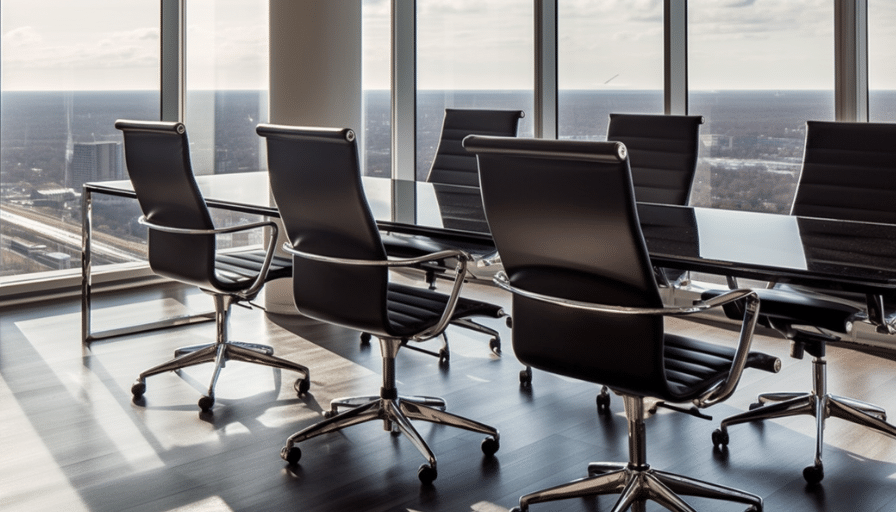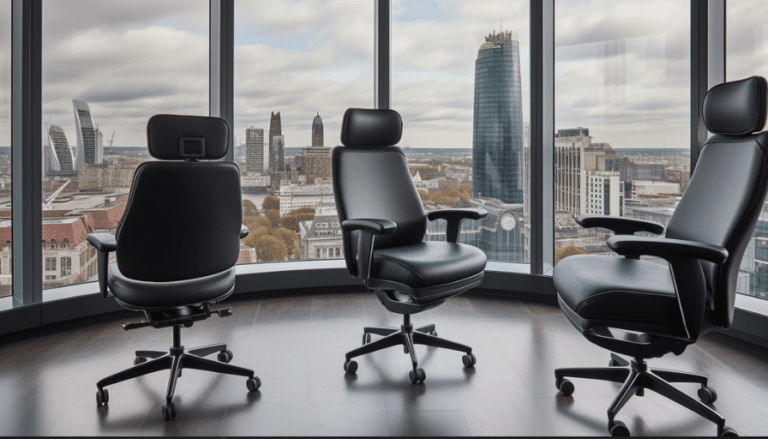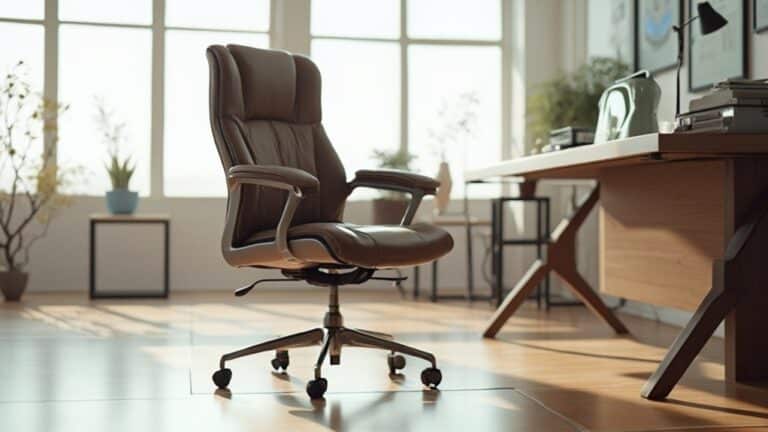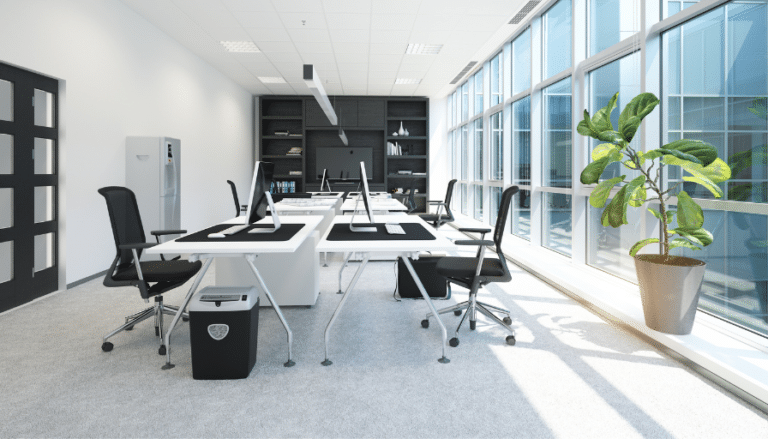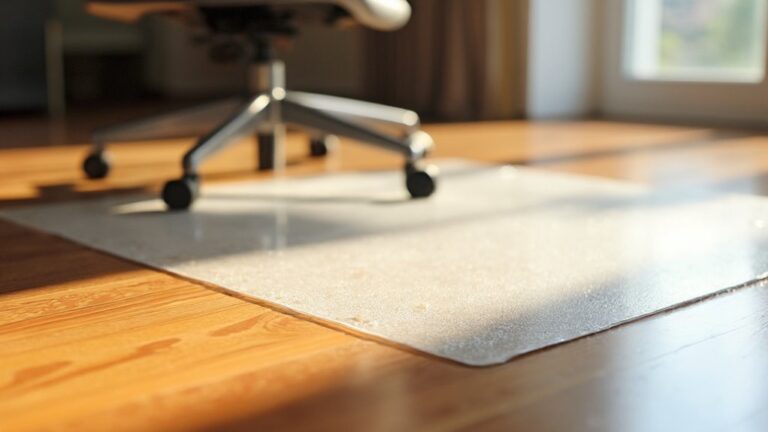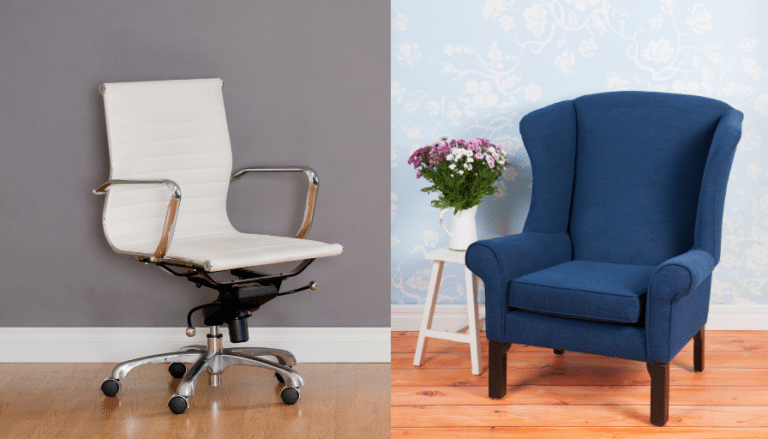How Long Do Office Chairs Last
When it comes to office chairs, you might wonder how long they actually last. The average lifespan typically ranges from 5 to 10 years, but several factors can impact that duration. Understanding these elements can help you make an informed choice for your workspace. So, what should you consider to guarantee your chair remains in good shape for as long as possible? Let’s explore the key aspects that influence chair longevity.
Average Lifespan of Office Chairs
Office chairs usually last between 5 to 10 years, depending on usage and maintenance. If you invest in a high-quality chair, it can serve you for up to 12 years with proper care. Keep in mind that regular maintenance plays a vital role in extending its lifespan. The type of material also matters; fabric chairs typically last about eight years, while leather chairs can endure around ten years. On the other hand, mesh chairs have a shorter lifespan of about five years. If you’re budgeting for replacements, plan on every few years based on these estimates. Additionally, durable components contribute to longer-lasting chairs, making quality an essential factor in your selection. Regular cleaning and maintenance are crucial for maximizing durability and preventing premature breakdowns. Investing in high-quality office chairs can significantly enhance comfort and productivity, making them a worthwhile consideration for any workplace. Furthermore, the average lifespan of office chairs can be significantly affected by factors such as usage frequency and environmental conditions.
Factors Influencing Lifespan
When it comes to how long your office chair lasts, several factors play a vital role. The quality of materials, how often and intensely you use the chair, and the environmental conditions all directly impact its lifespan. Understanding these elements can help you make better choices and extend the life of your chair. Regular maintenance is essential to ensure that your chair remains in good condition and can help maximize its longevity. Investing in high-quality materials can significantly affect the chair’s longevity. Additionally, high-quality chairs can last up to 10 years, providing a long-term solution for your seating needs.
Material Quality Impact
The quality of materials used in office chairs plays an essential role in determining their longevity. High-quality materials like steel or aluminum frames greatly outlast cheaper options such as plastic.
If you choose leather upholstery, you can enjoy a chair that lasts up to 10 years, thanks to its durability and resistance to wear. Fabric chairs can last around eight years with proper care, while mesh chairs typically last only five years.
Additionally, breathable, easy-to-clean fabrics help retain shape and comfort over time. Consider your environment—robust materials are best for busy offices, while UV-resistant options can protect against fading.
Ultimately, the right material selection directly impacts how well your chair withstands daily use and environmental factors.
Usage Patterns Effects
Usage patterns considerably impact how long your office chair lasts. If you’re using it for over eight hours a day, expect a shorter lifespan. Your habits matter too; leaning back excessively or putting too much weight on the armrests can lead to faster wear and tear. Inferior quality components can also significantly reduce the chair’s durability, especially if made from poor materials. Poor posture and rough handling damage components quicker, while neglecting maintenance, like cleaning and lubrication, reduces longevity. Regular cleaning can help mitigate some of the wear caused by daily use. Additionally, investing in high-quality materials can enhance the overall durability and performance of your chair. Rotating chairs among users helps distribute wear evenly, extending their life. Additionally, frequent adjustments to fit different users can wear down parts.
To maximize your chair’s lifespan, use it properly, avoid exceeding the weight limit, and take advantage of ergonomic features without over-adjusting. A little care goes a long way!
Environmental Conditions Influence
Environmental conditions play an essential role in determining how long your office chair lasts. Factors like temperature, humidity, and sunlight can greatly impact its lifespan.
Here are three key influences to take into account:
- Temperature Extremes: High heat can weaken materials, while low temperatures may cause cracking. A stable temperature helps maintain your chair’s integrity.
- Humidity Levels: Excess moisture can lead to mold and deterioration, whereas low humidity can dry out plastics and wood. Aim for balanced humidity for ideal durability.
- Sunlight Exposure: Direct sunlight fades upholstery and weakens materials. Keep your chair out of harsh light or use window coverings to mitigate damage.
Importance of Maintenance
While you mightn’t think about it often, maintaining your office chair is essential for its longevity and your comfort. Regular cleaning prevents dust buildup, which can lead to mechanical issues, while also reducing germs for a healthier workspace. Proper spinal alignment is crucial, as it ensures that the chair supports your body correctly during use, enhancing overall comfort. Promptly removing stains protects the material and keeps the upholstery looking fresh. Lubricating moving parts guarantees smooth operation, reduces friction, and prevents annoying squeaks. Regular inspections allow you to catch issues early, guaranteeing safety and stability, especially since regular maintenance can identify potential problems before they worsen. Investing in high-quality office chairs also means that with proper care, they can last significantly longer than their lower-quality counterparts. By creating a maintenance schedule, you can save on costly repairs down the line. Additionally, keeping an updated office chair inventory can help you track which chairs may need replacement or servicing.
Signs Indicating Replacement Needs
Recognizing when it’s time to replace your office chair is essential for maintaining comfort and productivity.
Look out for these signs that indicate a replacement is needed:
- Visible Damage: Cracks, tears, or sagging parts show that your chair is no longer reliable.
- Ergonomic Issues: If you struggle to adjust settings, your posture and comfort will suffer. Inadequate support from the backrest can exacerbate these ergonomic issues. Additionally, compressed foam in seat cushions can significantly reduce support, leading to increased discomfort over time. Prolonged use of a damaged chair can result in chronic issues like back pain and joint strain.
- Noise and Stability: Unusual noises or instability can signal faulty mechanisms.
Don’t wait until discomfort impacts your work.
If your chair causes health issues or looks worn out, replacing it can boost both your morale and professional image.
Environmental Impact on Chair Durability
When considering the longevity of your office chair, it’s important to also think about how the materials and design choices impact durability. Choosing durable materials like sustainable woods or recycled components not only reduces waste but also lowers environmental impact. Opt for natural upholstery fabrics like wool or linen, which are healthier and enhance indoor air quality. Additionally, investing in sustainable chairs can lead to longer lifespans, reducing the frequency of replacements. Modular chair designs allow for easy part replacements, promoting longevity and recyclability. Furthermore, mesh office chairs are known for their high-quality construction, which contributes to their extended durability. Be mindful of external factors such as sunlight, temperature, and humidity, as they can deteriorate chair materials over time. By selecting materials with a lower environmental impact, you can ensure your chair remains functional and stylish for years to come.
Cost-Effectiveness of High-Quality Chairs
Investing in a high-quality office chair can be one of the smartest decisions you make for your workspace.
While the initial cost may be higher, the long-term benefits are undeniable.
Consider these factors:
- Durability: High-quality chairs use superior materials, lasting longer than cheaper options. This increased durability and longevity often means they can withstand years of daily use without significant wear. Additionally, these chairs are engineered to accommodate a wide range of weights, ensuring heavy-duty performance for all users. Chairs with advanced ergonomic features often provide long-term health benefits, making them a worthwhile investment.
- Cost Savings: Fewer replacements mean more savings over time. Additionally, comfortable chairs help prevent health issues linked to long sitting hours, further justifying the investment.
- Reduced Maintenance: Quality chairs require less upkeep, saving you time and money.
Benefits of Ergonomic Design
Ergonomic design transforms the way you experience comfort in your workspace. These chairs align with your body’s natural curves, improving your sitting posture and reducing spinal strain. You’ll notice a significant decrease in back pain thanks to lumbar support that stabilizes your lower back. Features like headrests relieve neck and shoulder stiffness, while proper seat depth minimizes hip pressure. Improved circulation from correct posture helps prevent numbness and swelling. Additionally, ergonomic chairs are designed to reduce long-term risks associated with bad posture, promoting a healthier sitting experience. The adjustable height feature ensures that your feet remain flat on the floor, which further enhances overall posture. Investing in a quality ergonomic chair can significantly extend chair lifespan, ensuring you enjoy its benefits for many years. Furthermore, these chairs improve blood circulation, which supports cognitive functions and memory retention while you work.
Not only does this design enhance your comfort, but it also boosts productivity. When you’re comfortable, you stay focused and efficient, leading to increased satisfaction and fewer absences. With adjustable features, ergonomic chairs adapt to your unique needs, making your workspace a more enjoyable environment.
Role of Material Quality
When you’re choosing an office chair, the material quality plays a vital role in its lifespan and comfort. High-quality materials can enhance durability and require less maintenance, while cheap options may lead to quicker wear and tear. Understanding these differences helps you make a better decision for your workspace needs. For instance, mesh chairs excel in breathability, making them a great choice for warmer environments or those prone to sweating. Additionally, ergonomic adjustability features in mesh chairs enhance comfort, allowing for a more personalized seating experience.
High-Quality Materials Benefits
High-quality materials play an essential role in the longevity and comfort of office chairs, ensuring they withstand daily use while providing the support you need.
Investing in a chair made from superior materials enhances your work experience in several ways:
- Durability: Materials like steel and high-density foam resist wear and tear, ensuring your chair lasts longer.
- Ergonomic Support: High-quality components promote proper posture, reducing strain and fatigue during long hours. This is crucial because proper posture maintenance significantly reduces strain on muscles and joints, which is important for employee satisfaction. Additionally, materials like mesh fabric provide breathability, which can help maintain comfort during extended periods of sitting.
- Comfort: Premium materials enhance cushioning and breathability, keeping you comfortable and focused.
Choosing a chair crafted from high-quality materials not only saves you money in the long run but also boosts your productivity in a supportive work environment.
Impact of Cheap Materials
Although choosing an office chair might seem straightforward, opting for one made with cheap materials can severely impact its durability and your overall experience.
Cheap components, like low-grade plastics and thin upholstery, often lead to wear and tear, shortening the chair’s lifespan to as little as six months. You might notice sagging seats or unstable frames, compromising comfort and support. Task management apps can help you organize your chair selection process to ensure you make a well-informed decision.
The inferior quality of materials can also result in visible tears, making the chair look worn out quickly. While these chairs may seem budget-friendly initially, you’ll end up spending more on replacements.
Ultimately, investing in high-quality materials not only enhances durability but also improves your comfort and productivity in the long run.
Durability and Maintenance Factors
Choosing the right materials for your office chair is key to its durability and maintenance. High-quality materials not only extend the life of your chair but also reduce the frequency of replacements. Here are three critical factors to evaluate:
- Material Type: Opt for durable fabrics, leather, or breathable mesh, each with specific maintenance needs. Ergonomic features in the material also contribute to the chair’s longevity and comfort. Additionally, selecting materials with high durability can significantly reduce the risk of premature wear.
- Environmental Conditions: Keep your chair away from extreme temperatures and high humidity to prevent material degradation.
- Usage Patterns: Adhere to weight limits and avoid excessive rocking, as these behaviors can accelerate wear.
Regular cleaning and care tailored to the material will further enhance your chair’s longevity, ensuring it remains a reliable part of your workspace for years to come.
Tips for Extending Chair Lifespan
To guarantee your office chair lasts as long as possible, it’s essential to invest time in both quality and maintenance. Start by choosing a chair with a high-quality frame and durable upholstery, as these materials resist wear and tear.
Regularly clean your chair to prevent dirt buildup and keep it hygienic. Lubricate moving parts to promote smooth operation, and tighten any loose screws to maintain stability. Conduct frequent inspections to catch potential issues early.
If you’re using the chair heavily, consider rotating it with another to evenly distribute wear. Finally, be mindful of environmental factors like temperature and sunlight exposure to protect your chair from premature degradation.
With these tips, you can greatly extend your chair’s lifespan.
Frequently Asked Questions
Can I Repair an Office Chair Myself?
Yes, you can repair an office chair yourself. Tightening screws, replacing wheels, and cleaning can fix common issues. For fabric tears, try sewing or using a repair kit. Just make certain you’re comfortable with the required tasks.
Are There Specific Cleaning Products Safe for Office Chairs?
Yes, there are specific cleaning products safe for office chairs. Use mild soap for plastic, gentle cleaners for leather, and foam cleaners for fabric. Always test any product on an inconspicuous area first to avoid damage.
How Do I Choose the Right Office Chair for My Height?
To choose the right office chair for your height, make certain it adjusts to allow your feet to touch the floor and your knees to bend at a 90-degree angle for ideal comfort and support.
What Is the Best Way to Dispose of an Old Office Chair?
To dispose of your old office chair, consider recycling it at local centers, donating it if it’s still usable, or using professional removal services. Always check local guidelines to guarantee proper disposal methods.
Do Office Chairs Have Weight Limits?
Yes, office chairs do have weight limits. These limits guarantee structural integrity, safety, and comfort. Choosing a chair that supports your weight is essential for maintaining its durability and your overall ergonomic experience.
Conclusion
To sum up, understanding how long office chairs last and the factors that influence their lifespan can help you make informed choices. By maintaining your chair and recognizing the signs of wear, you can extend its life. Investing in a high-quality, ergonomic chair made from durable materials not only enhances your comfort but also proves cost-effective in the long run. So, take care of your chair, and it’ll take care of you!
References
- https://nulifechairs.com/how-long-do-office-chairs-last/
- https://manuu.edu.in/dde/sites/default/files/DDE/DDE-SelfLearnmaterial/BA-6thSemester/Englishba6th28may24.pdf
- https://offisavvy.com/how-long-do-office-chairs-last-and-when-to-replace-them/
- https://www.pvcc.edu/sites/default/files/writing_for_success_handbook.pdf
- https://ehs.web.baylor.edu/sites/g/files/ecbvkj1581/files/2023-03/when_to_replace_an_office_chair.pdf
- https://ergotune.com/blogs/articles/how-long-do-desk-chairs-last
- https://aceofficesystems.com/blogs/news/how-long-do-office-chairs-last
- https://vaseat.com/how-long-should-you-replace-office-chair/
- https://de.sihoooffice.com/blogs/bloggen/how-long-does-an-office-chair-last-factors-tips-and-lifespan
- https://aceofficesystems.com/blogs/news/what-type-of-office-chair-lasts-the-longest-1

